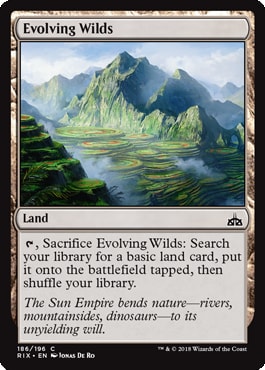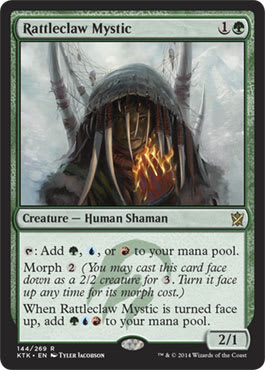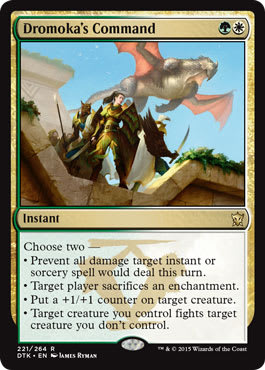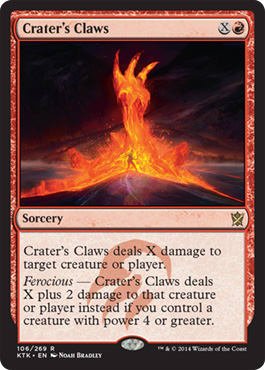As I write this article, we have one hundred forty out of two hundred seventy-four cards spoiled, including lands. I want to tackle Standard early to test for Pro Tour Battle for Zendikar because there is limited time to prepare for both Constructed and Draft. It’s hard to have meaningful discussions about Draft before the full spoiler is out, so Standard it is.
My two favorite cards in post-rotation Standard are Mantis Rider and Siege Rhino. In the past, that meant I would have to build two different decks if I wanted to play both. Before rotation, these two creatures were the cornerstones of the strongest archetypes: Abzan Aggro and Abzan Control to play Siege Rhino and Jacekai to play Mantis Rider.
What if I told you that the third option is to play both . . .
Five-Color Aggro ? Battle for Zendikar Standard | Kyle Boggemes
- Creatures (28)
- 4 Heir of the Wilds
- 4 Mantis Rider
- 4 Rattleclaw Mystic
- 4 Savage Knuckleblade
- 4 Siege Rhino
- 4 Hangarback Walker
- 2 Kolaghan, the Storm's Fury
- 2 Tasigur, the Golden Fang
- Spells (8)
- 4 Crackling Doom
- 4 Dromoka's Command
- Lands (24)
- 1 Forest
- 1 Island
- 1 Mountain
- 1 Plains
- 1 Swamp
- 1 Canopy Vista
- 1 Cinder Glade
- 1 Prairie Stream
- 1 Smoldering Marsh
- 1 Sunken Hollow
- 2 Bloodstained Mire
- 2 Flooded Strand
- 2 Polluted Delta
- 2 Windswept Heath
- 2 Wooded Foothills
- 4 Evolving Wilds
- Sideboard (15)
- 4 Arashin Cleric
- 2 Disdainful Stroke
- 3 Duress
- 2 Sarkhan Unbroken
- 2 Den Protector
- 2 Silkwrap
This is probably among the most fun decks I have ever played. It reminds me of the times I was able to play Ancient Ziggurat in Standard. Those were grand times.
Before I dig into the spells, I want to talk about the mana because I’m sure everyone is skeptical at this point. I was reading an article by Sam Black in which he talked about a mana base that was identical to this. Naturally, this deck was designed to push the limits of such a mana base, and it passed. The mana in the new Standard is incredible thanks to the dual lands. From now on, I’m going to call them tango lands because I like puns; you have been warned.
Evolving Wilds is able to find all five colors since I have one of each basic land. The fetch lands are able to search for two different basic lands, but they can also search for three tango lands. Each fetch land can find four different colors of mana. The color it can’t fetch is the one that completes a wedge. For example, Wooded Foothills cannot produce blue mana because of Temur, and Windswept Heath doesn’t produce black because of Abzan. If you draw two different fetch lands, you can access all five colors. This doesn’t mean you can produce all five because the maximum number of colors a single land can produce is two. If you draw three lands in a game, you can have all three colors, but you need to be careful how you fetch because those three colors might not be able to cast the right spell. Ideally, you want 4 mana to mix and match the colors you can produce on the same turn. The corner case here is if you draw two basic lands. Another potentially awkward scenario is if you draw two of the same fetch land—then, your two lands don’t have the option to find all five colors.
So now that I showed you it is possible to find all five colors by turn three and different variations by turn four, the real question to answer is how consistently this happens. Since Evolving Wilds finds you any color and fetch lands find you four different colors, having all of the options by the fourth turn is very reasonable as long as you draw four actual lands out of twenty-four.
This is a first pass at the mana base, and it might be correct to play more of particular fetch-land combinations or additional tango lands. I’m hesitant to add creature lands because they cannot be fetched and don’t contribute to your basic land count for tangos to enter the battlefield untapped. With that said, it would be nice to attack with a 3/3 hexproof in the midgame instead of having an Evolving Wilds. Since they’re enemy colors, it can also diversify the colors the dual lands produce; I don’t want tango colors overlapping with creature lands.
I have played about twenty games with this deck, and the mana has rarely been an issue. It becomes even better because of the new mulligan rule; when you scry, it’s very clear what you’re looking for. If you have a couple lands in your hand, you want to find a land that adds the remaining colors of mana. If there are too many lands in your hand, you keep threats you can cast on top. I’m not punished for mulliganing aggressively, although I have taken very few mulligans so far. It should be noted that scrying on the play is weaker than on the draw if the first-turn plan is to search for a land.
Now that we got the wacky mana out, of the way let’s talk about the spells . . .
Hangarback Walker is among the best creatures in Standard, so it fits the theme of this deck: playing good cards. The lack of color requirements in the early game means I don’t have to stretch myself to cast it on turn two and then a Savage Knuckleblade or Mantis Rider the following turn. There are twenty-four lands and four Rattleclaw Mystics, so I like having a mana sink.
Heir of the Wilds probably appears to be an odd choice at first glance because I have access to every color. I have liked Heir of the Wilds in Standard in the past, and Fleecemane Lion leaving means we once again have room. Since it’s only a single green mana, I can fetch a tango on turn one and find a basic on turn two to cast it with numerous combinations. We also can’t forget how well it fights with Dromoka's Command and how many creatures trigger ferocious: Savage Knuckleblade, Tasigur, the Golden Fang, Siege Rhino, and Kolaghan, the Storm's Fury. The current rule with triggers also makes this card better because you don’t have to announce it until it becomes relevant. It makes communicating awkward because you don’t want to remind your opponent, and your opponent doesn’t want to ask because he or she is reminding you if you forgot. This will favor you in the end because your opponent is more likely to forget what Heir of the Wilds does.
Rattleclaw Mystic can help ramp into Siege Rhino and Kolaghan while also fixing your mana. If you play against an unsuspecting opponent, a morphed Mystic can look like a Den Protector, which can create a distraction. I don’t like Beastcaller Expert because I can’t cast Dromoka's Command or Crackling Doom, and I want to double-spell in the midgame. It also doesn’t help with creatures’ activated abilities, and I have Tasigur and Savage Knuckleblade, which require specific colors. Planeswalkers such as Sarkhan Unbroken need a lot of mana as well. The 1/1 body is also bad at attacking, and I don’t need the mana all of the time.
Tasigur does some cool things in this deck because delve plays well with your fourteen fetch lands. The worst spell to bring back is Rattleclaw Mystic, but there are some great hits when you flip over a gold card. The 4 power triggers ferocious, as previously noted, and the single black mana in the casting cost enables some powerful double-spell turns.
Now that we got the monochromatic spells out of the way, the fun part comes. When I was selecting which gold cards to play, I didn’t hold back, as I wanted to see what this deck could really do. The obvious cards to add are Siege Rhino, Mantis Rider, and Savage Knuckleblade. My final gold creature is Kolaghan, the Storm's Fury because it follows the deck’s theme of playing bombs that deal damage when they enter the battlefield. There need to be more expensive spells that reward me for playing Rattleclaw Mystic, and it also turns it into a bigger threat in the midgame. The triggered ability is also nice because I can do something useful with all of the Thopter tokens from Hangarback Walker.
The removal spells are also some of the most powerful in the format; very few decks can actually support Crackling Doom because it’s three colors that aren’t green. I am going to assume there will be an Eldrazi deck, and I am ready to destroy some indestructible monsters. Dromoka's Command is the best removal spell in the format when you are playing with creatures; my team came prepared to fight. Now that Stoke the Flames has rotated, there aren’t many ways to deal with a 4/4 Mantis Rider. I also don’t main-deck enchantments because Dromoka's Command has warped the format. It’s backbreaking to lose both a creature and an enchantment to an opposing Command.
Making a sideboard for a five-colored deck isn’t an easy task. When selecting cards, the initial goal was to have four cards to come in against aggressive red decks because Crackling Doom is terrible against them. I also wanted enough cards against control to take out Dromoka's Command and Heir of the Wilds. There aren’t any cards I don’t care to have against midrange decks, but I do want some bombs to help take control of the midgame. Heir of the Wilds is quite good against opposing green decks because nobody wants to block it and trade a big creature, and there’s a floor to how bad a 3/3 deathtouch for 2 mana can be.
Arashin Cleric is a great threat against red because I imagine the level-zero red deck goes wide with Atarka's Command. The 1/3 body blocks Goblin tokens from Dragon Fodder and Hordeling Outburst, which is exactly where I want to be. It’s also only a single color, which makes double-spelling in the midgame easier.
Duress and Disdainful Stroke come in against various decks that assume a controlling role against me. Abzan Control has annoying cards like Languish that I want to counter, but it also hits Siege Rhino and Ob Nixilis Reignited. Duress hits the sweepers I want to fight, but it also takes Ojutai's Command from Jacekai decks. There isn’t a more helpless feeling than when you are playing against W/U and the opponent has 4 mana available; you can pass the turn, but then the opponent can simply Dig Through Time.
Sarkhan is my fatty of choice that comes in against midrange decks, but also against control. The idea is to land this powerful Planeswalker and then +1 it to add black mana and cast Duress to take the opponent’s next answer. I also like Sarkhan, the Dragonspeaker, but the double-red in the casting cost was more awkward than making three different colors. I’m not going to lie—it’s a pretty weird problem to have, but try to avoid double-colored spells if you want to change this list.
Den Protector is another grindy threat that can help with the Duress plan against slower decks. I choose to focus on this because I will have early-game threats covered by Siege Rhino, Mantis Rider, and Savage Knuckleblade, so I just need to hold my early advantage with a bit of disruption. Make sure you don’t go overboard because diluting your threat base could be a real issue. I want a Duress to throw opponents off, but I don’t want to draw three hand-disruption spells to try to rip an opponent’s hand apart because then I will draw too many bad cards in the late game.
Silkwrap is a card that I think grows more powerful with the rotation. It can remove a Hangarback Walker and not give the opponent any tokens. I actually want this as an early way to interact with Jace, Vryn's Prodigy. Removing Jacekai’s creature base from the game is key because I want to make the opponent’s Ojutai's Commands less powerful. It’s pretty demoralizing when your Siege Rhino is countered and the opponent rebuys a Jace. There are other potential removal spells to choose from because it can be awkward against opposing Dromoka's Commands.
This deck is by no means a finished product, and being able to play any color gives me a lot of room for improvement. There are a few cards I was considering that either were cut or are on the cusp of being played.
Crater's Claws — It’s not too tough to trigger ferocious. An early removal spell that can turn lethal in the midgame is great because so many of my spells deal damage immediately.
Wild Slash — This is another early removal spell that can also deal the final points of damage. I felt that, with twelve 2-drops, I was already good against an early onslaught, so I cut them. There were also games in which I would draw too many Slashes and Rattleclaw Mystics, and I wanted a version that was better at top-decking.
Anafenza, the Foremost — This is a solid creature, but I already have eight great 3-drops in Mantis Rider and Savage Knuckleblade. Also, this probably isn’t common knowledge, but Anafenza and Mantis Rider don’t play well together with the vigilance not tapping to attack. I also drew some weird hands with which I wanted black mana on turn three, and by cutting Anafenza, I was able to wait until turn four for Siege Rhino. Crackling Doom is a 3-drop that costs black mana, but I rarely want to cast it that early.
This is an early pass at making this deck, but I think it’s incredibly powerful, and I would not be surprised if I end up playing this at the Pro Tour. If anything, it’s a great choice for Friday Night Magic because it’s so fun to play. I would highly suggest goldfishing this deck to see how the mana plays out—most of your brain power will be devoted to which lands you will fetch and when. There are many four-ofs in this list, so it makes thinking about potential draws easier, but it still takes practice. I don’t have many cards from the new set at the moment, but that may change in the coming week.
Thanks for reading, now go and attack with Mantis Rider and Siege Rhino!
-Kyle






























